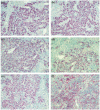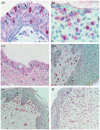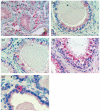Expression of toll-like receptors in genital tract tissues from normal and HIV-infected men
- PMID: 20528831
- PMCID: PMC4053245
- DOI: 10.1111/j.1600-0897.2010.00877.x
Expression of toll-like receptors in genital tract tissues from normal and HIV-infected men
Abstract
Problem: cells of the innate immune system use Toll-like receptors (TLRs) to recognize and respond to invading pathogens. This study was carried out to characterize TLR expression in the human male genital tract, an initial infection site for several sexually transmitted pathogens.
Method of study: immunohistochemistry was used to detect expression of TLRs 1-9 in genital tract tissues from HIV(-) and HIV(+) men.
Results: in HIV(-) men, TLR1(+) leukocytes were detected throughout the genital tract. Leukocytes in the penile urethra also expressed TLRs2, 3, 5, 7 and 9. Epithelial cells in most tissues did not express TLRs; exceptions were the prostate, where TLRs3 and 8 were observed on the apical surface of luminal epithelial cells, and the penile urethra, where epithelial cells expressed TLR9. In genital tissues from HIV(+) men with AIDS, few TLR(+) cells were detected.
Conclusion: cells in the male genital tract can express a variety of TLRs. The penile urethra contained the highest number of TLR(+) cells, indicating that this tissue plays a major role in the innate immune defense of the male genital tract. Overall, TLR expression was reduced in genital tissues from HIV(+) men.
Figures






Similar articles
-
Members of the Toll-like receptor family of innate immunity pattern-recognition receptors are abundant in the male rat reproductive tract.Biol Reprod. 2007 Jun;76(6):958-64. doi: 10.1095/biolreprod.106.059410. Epub 2007 Feb 21. Biol Reprod. 2007. PMID: 17314314
-
Induction of innate immune responses in the female genital tract: friend or foe of HIV-1 infection?Am J Reprod Immunol. 2011 Mar;65(3):344-51. doi: 10.1111/j.1600-0897.2010.00945.x. Epub 2011 Jan 12. Am J Reprod Immunol. 2011. PMID: 21223417 Review.
-
TLR activation pathways in HIV-1-exposed seronegative individuals.J Immunol. 2010 Mar 1;184(5):2710-7. doi: 10.4049/jimmunol.0902463. Epub 2010 Feb 1. J Immunol. 2010. PMID: 20124101
-
Toll-like receptors and genital tract infection.Int J STD AIDS. 2010 Mar;21(3):153-7. doi: 10.1258/ijsa.2009.009525. Int J STD AIDS. 2010. PMID: 20215617 Review.
-
Chlamydia trachomatis infection of the male genital tract: an update.J Reprod Immunol. 2013 Nov;100(1):37-53. doi: 10.1016/j.jri.2013.05.002. Epub 2013 Jul 16. J Reprod Immunol. 2013. PMID: 23870458 Review.
Cited by
-
Innate and acquired immunity in the human penile urethra.J Reprod Immunol. 2011 Mar;88(2):219-27. doi: 10.1016/j.jri.2011.01.006. Epub 2011 Feb 24. J Reprod Immunol. 2011. PMID: 21353311 Free PMC article. Review.
-
Effects of Goji Berry Supplementation on Immune-Related and Antioxidant Gene Expression in the Male Rabbit Reproductive Tract.Animals (Basel). 2025 Jun 29;15(13):1921. doi: 10.3390/ani15131921. Animals (Basel). 2025. PMID: 40646820 Free PMC article.
-
TLR2 and TLR4 bridge physiological and pathological inflammation in the reproductive system.Commun Biol. 2025 Jul 5;8(1):1008. doi: 10.1038/s42003-025-08424-x. Commun Biol. 2025. PMID: 40618011 Free PMC article. Review.
-
The Human Penis Is a Genuine Immunological Effector Site.Front Immunol. 2017 Dec 14;8:1732. doi: 10.3389/fimmu.2017.01732. eCollection 2017. Front Immunol. 2017. PMID: 29312291 Free PMC article.
-
HIV infection and immune defense of the penis.Am J Reprod Immunol. 2011 Mar;65(3):220-9. doi: 10.1111/j.1600-0897.2010.00941.x. Epub 2011 Jan 9. Am J Reprod Immunol. 2011. PMID: 21214659 Free PMC article. Review.
References
-
- Janeway CA, Jr, Medzhitov R. Innate immune recognition. Annu Rev Immunol. 2002;20:197–216. - PubMed
-
- Akira S, Takeda K, Kaisho T. Toll-like receptors: critical proteins linking innate and acquired immunity. Nat Immunol. 2001;2:675–680. - PubMed
-
- Iwasaki A, Medzhitov R. Toll-like receptor control of the adaptive immune responses. Nat Immunol. 2004;5:987–995. - PubMed
-
- Bauer S, Muller T, Hamm S. Pattern recognition by Toll-like receptors. Adv Exp Med Biol. 2009;653:15–34. - PubMed
-
- Lemaitre B, Nicolas E, Michaut L, Reichhart JM, Hoffmann JA. The dorsoventral regulatory gene cassette spatzle/Toll/cactus controls the potent antifungal response in Drosophila adults. Cell. 1996;86:973–983. - PubMed
Publication types
MeSH terms
Substances
Grants and funding
LinkOut - more resources
Full Text Sources
Medical
Research Materials

